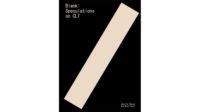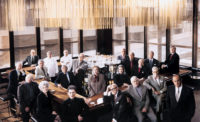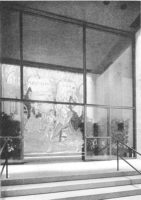Review of 'Unless: The Seagram Building Construction Ecology'
By Kiel Moe

Unless: The Seagram Building Construction Ecology, by Kiel Moe. Actar, 316 pages, $34.95.
Architects & Firms
Some of the most pervasive myths of modern architecture surround the Seagram Building, the emblem of standardization—manifested by the extruded shaft of the tower, the applied bronze I-beams that are stand-ins for the structural steel frame encased in concrete within, and the urban stance of the building, an autonomous prismatic object set back on a spare granite plaza. Every aspect of Mies van der Rohe’s building has been extensively documented, illustrated, and imitated. Kiel Moe’s critical assessment of this Modernist icon reads it through the lenses of material ecologies and environmental load. In the process, he demolishes so much of its mythology.
The book’s title implies a dire warning: “Unless architects begin to describe buildings as terrestrial events, processes, and artifacts, architects will—to professional and collective peril—continue to operate outside the key environmental and political dynamics of this century.” Moe assesses architecture as a material, geological, and ecological artifact—essentially the substance of which it is made, and the embodied energy and labor that it represents. To do so, he performs a painstaking material audit of the Seagram Building, modeling and measuring the quantities of steel, concrete, and glass that make up the tower’s 38 stories.
Elaborating on a method he developed in his previous book, Empire, State & Building, Moe tracks the building components back to the fabricators that produced them, to the quarries and mines where the raw materials were extracted, and ultimately back to the ground. He sees the Seagram Building as an “exquisite pile of technomass, attached to perhaps less exquisite inequities in its world.”
Moe derives the term “terrestrial,” for his investigation, from French sociologist Bruno Latour, as pertaining to “all the human and nonhuman, organic and inorganic, ‘natural’ and ‘unnatural’ dynamics of entities on the surface of the planet.” The shifting of materials in the making of a building creates “environmental loads,’’ which Moe argues are being asymmetrically displaced from centers of power and wealth onto the peripheries where these materials come from. Only by understanding the expanded web of materials, their sources, waste, by-products, and toxicological impacts can we gain a true accounting of the real environmental footprint of architecture.
The Seagram Building’s “bronze” I-beams are actually brass—a combination of copper and zinc. Probably the copper was a mix of recycled and new copper, likely to have come from the Chuquicamata mine in Chile’s Atacama Desert. Here Moe finds a mining town crushed, literally, by the tailings from the open pit mine, and a history of illnesses among the workers. In tracing the production of the famous I-beams, we learn about the custom die operation, and the meticulous process of straightening and hand-polishing the extrusions to achieve the perfect “machine-age” look. In Butler, Pennsylvania, the source of the pink-tinted glass Mies specified, he details the history of the Franklin Glass factory, the pouring and casting of the glass, and the labor of polishing the unique lites. The story of the company is one of growth, obsolescence, bankruptcy, and factory closure.
Mies’s masterpiece is not emblamatic of modern standardization but is a bespoke artifact, and that comes at a high cost: it was the most expensive office building ever constructed at the time, and now Moe is calculating the environmental and social costs.
But he is not interested in vilifying or valorizing the building or its creators. He wants to completely reevaluate the way we think about architecture, the way we describe it, and the way we value it. Architecture has tremendous agency and responsibility. This book demands that we rethink the very substance of architecture and its expanded footprint so we can understand its larger impact in a “terrestrial” world.





